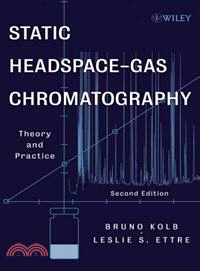Static Headspace-Gas Chromatography: Theory And Practice, Second Edition
商品資訊
定價
:NT$ 7513 元優惠價
:90 折 6762 元
若需訂購本書,請電洽客服 02-25006600[分機130、131]。
相關商品
商品簡介
作者簡介
目次
商品簡介
The only reference to provide both current and thorough coverage of this important analytical technique
Static headspace-gas chromatography (HS-GC) is an indispensable technique for analyzing volatile organic compounds, enabling the analyst to assay a variety of sample matrices while avoiding the costly and time-consuming preparation involved with traditional GC.
Static Headspace-Gas Chromatography: Theory and Practice has long been the only reference to provide in-depth coverage of this method of analysis. The Second Edition has been thoroughly updated to reflect the most recent developments and practices, and also includes coverage of solid-phase microextraction (SPME) and the purge-and-trap technique. Chapters cover:
* Principles of static and dynamic headspace analysis, including the evolution of HS-GC methods and regulatory methods using static HS-GC
* Basic theory of headspace analysis-physicochemical relationships, sensitivity, and the principles of multiple headspace extraction
* HS-GC techniques-vials, cleaning, caps, sample volume, enrichment, and cryogenic techniques
* Sample handling
* Cryogenic HS-GC
* Method development in HS-GC
* Nonequilibrium static headspace analysis
* Determination of physicochemical functions such as vapor pressures, activity coefficients, and more
Comprehensive and focused, Static Headspace-Gas Chromatography, Second Edition provides an excellent resource to help the reader achieve optimal chromatographic results. Practical examples with original data help readers to master determinations in a wide variety of areas, such as forensic, environmental, pharmaceutical, and industrial applications.
Static headspace-gas chromatography (HS-GC) is an indispensable technique for analyzing volatile organic compounds, enabling the analyst to assay a variety of sample matrices while avoiding the costly and time-consuming preparation involved with traditional GC.
Static Headspace-Gas Chromatography: Theory and Practice has long been the only reference to provide in-depth coverage of this method of analysis. The Second Edition has been thoroughly updated to reflect the most recent developments and practices, and also includes coverage of solid-phase microextraction (SPME) and the purge-and-trap technique. Chapters cover:
* Principles of static and dynamic headspace analysis, including the evolution of HS-GC methods and regulatory methods using static HS-GC
* Basic theory of headspace analysis-physicochemical relationships, sensitivity, and the principles of multiple headspace extraction
* HS-GC techniques-vials, cleaning, caps, sample volume, enrichment, and cryogenic techniques
* Sample handling
* Cryogenic HS-GC
* Method development in HS-GC
* Nonequilibrium static headspace analysis
* Determination of physicochemical functions such as vapor pressures, activity coefficients, and more
Comprehensive and focused, Static Headspace-Gas Chromatography, Second Edition provides an excellent resource to help the reader achieve optimal chromatographic results. Practical examples with original data help readers to master determinations in a wide variety of areas, such as forensic, environmental, pharmaceutical, and industrial applications.
作者簡介
Dr. BRUNO KOLB is an internationally recognized expert on gas chromatography. Until his retirement in 1996, he managed the GC Applications Laboratory at Perkin-Elmer Corporation, Germany; he has also been involved in instrument development with special emphasis on specific detectors. He has been a guest lecturer at the University of Konstanz, as well as at international meetings. He has published many journal articles and book chapters, and is the author of a textbook on gas chromatography.
Dr. LESLIE S. ETTRE was a senior scientist at Perkin-Elmer Corporation until his retirement in 1990. Between 1988 and 1995 he served as an adjunct professor in the Department of Chemical Engineering at Yale University, and from 1995 until 2004 he continued his association with the school as a research affiliate. In addition to lecturing widely in the field of gas chromatography, Dr. Ettre has published over 200 scientific and technical papers, and is the author and editor of numerous books, including Encyclopedia of Industrial Chemical Analysis. He has received numerous awards, including the National Award in Chromatography of the American Chemical Society and the AJP Martin Award of the Chromatographic Society—the highest honors in the United States and Europe, respectively.
Dr. LESLIE S. ETTRE was a senior scientist at Perkin-Elmer Corporation until his retirement in 1990. Between 1988 and 1995 he served as an adjunct professor in the Department of Chemical Engineering at Yale University, and from 1995 until 2004 he continued his association with the school as a research affiliate. In addition to lecturing widely in the field of gas chromatography, Dr. Ettre has published over 200 scientific and technical papers, and is the author and editor of numerous books, including Encyclopedia of Industrial Chemical Analysis. He has received numerous awards, including the National Award in Chromatography of the American Chemical Society and the AJP Martin Award of the Chromatographic Society—the highest honors in the United States and Europe, respectively.
目次
Preface.
Preface to the First Edition.
List of Acronyms and Symbols.
1. General introduction.
1.1 Principles of headspace analysis .
1.2 Types of headspace analysis.
1.2.1 Principles of static headspace - gas chromatography (HS-GC).
1.2.2 Principles of dynamic headspace - gas chromatography.
1.3 The evolution of the HS-GC methods.
1.4 Headspace - gas chromatography literature.
1.5 Regulatory methods utilizing (static) HS-GC.
1.6 References.
2. Theoretical background of HS-GC and its applications.
2.1 Basic theory of headspace analysis.
2.2 Basic physicochemical relationships.
2.3 Headspace sensitivity.
2.3.1 Influence of temperature on vapor pressure and partition coefficient.
2.3.2 Influence of temperature on headspace sensitivity for compounds with differing partition coefficients.
2.3.3 Influence of sample volume on headspace sensitivity for compounds with differing partition coefficients.
2.3.4 Changing the sample matrix by varying the activity coefficient.
2.4 Headspace linearity.
2.5 Duplicate analyses.
2.6 Multiple headspace extraction (MHE).
2.6.1 Principles of MHE.
2.6.2 Theoretical background of MHE.
2.6.3 Simplified MHE calculation.
2.7 References.
3. The technique of HS-GC.
3.1 Sample vials.
3.1.1 Types.
3.1.2 Selection of vial volume.
3.1.3 Vial cleaning.
3.1.4 Wall adsorption effects.
3.2 Caps.
3.2.1 Pressure on caps.
3.2.2 Safety closures.
3.3 Septa.
3.3.1 Types.
3.3.2 Septum blank.
3.3.3 Should a septum be pierced twice?.
3.4 Thermostatting.
3.4.1 Influence of temperature.
3.4.2 Working modes.
3.5 The fundamentals of headspace sampling systems.
3.5.1 Systems using gas syringes.
3.5.2 Solid-phase microextraction (SPME).
3.5.2.1 Comparison of the sensitivities in HS-SPME and direct static HS-GC.
3.5.3 Balanced-pressure sampling systems.
3.5.4 Pressure/loop systems.
3.5.5 Conditions for pressurization systems.
3.5.6 The volume of the headspace sample.
3.5.6.1 Sample volume with gas syringes.
3.5.6.2 Sample volume with loop systems.
3.5.6.3 Sample volume with the balanced-pressure system.
3.6 Use of open-tubular (capillary) columns.
3.6.1 Properties of open-tubular columns for gas samples.
3.6.2 Headspace sampling with split or spitless?.
3.6.3 Comparison of split- and splitless headspace sampling.
3.6.4 Band broadening during sample introduction.
3.6.5 Temperature influence on band broadening.
3.6.6 The combination of different columns and detectors.
3.7 Enrichment techniques in HS-GC.
3.7.1 Systems for cryogenic trapping.
3.7.1.1 Systems for Cryogenic condensation.
3.7.1.2 Trapping by cryogenic focusing.
3.7.1.3 Influence of temperature on cryogenic focusing.
3.7.1.4 Comparison of the various techniques of cryogenic trapping.
3.7.2 Influence of water in cryogenic HS-GC.
3.7.2.1 Water removal in static HS-GC.
3.7.2.2 Applications.
3.7.3 Enrichment by adsorption.
3.7.3.1 Water removal from an adsorption trap.
3.8 Special techniques with the balanced-pressure systems.
3.8.1 Instrumentation for MHE.
3.8.2 Backflushing.
3.9. Reaction HS-GC.
3.9.1 Derivatization in the headspace vial.
3.9.1.1 Methylation.
3.9.1.2 Esterification.
3.9.1.3 Transesterification.
3.9.1.4 Acetylation.
3.9.1.5 Carbonyl compounds.
3.9.2 Subtraction HS-GC.
3.9.3 Special reactions.
3.9.4 HS-GC analysis of volatile derivatives from inorganic compounds.
3.10 References.
4. Sample handling in HS-GC.
4.1 Equilibration.
4.1.1 Gas samples.
4.1.2 Liquid samples.
4.1.3 Solid samples.
4.2 Solution approach.
4.3 Sample handling and sample introduction.
4.3.1 Gas samples.
4.3.2 Liquid samples.
4.3.3 Solid samples.
4.4 Preparation of standard solutions.
4.4.1 Preparation of a standard solution from a liquid or solid substance.
4.4.2 Preparation of a standard solution from a gaseous compound.
4.5 Influence of the matrix.
4.5.1 Clean matrix is available.
4.5.2 Matric effect can be eliminated.
4.5.3 Artificial matrix can be prepared.
4.6 Methods aiming the complete evaporation of the analyte.
4.6.1 The total vaporization technique (TVT).
4.6.2 The full evaporation technique (FET).
4.6.3 Calculation of the extraction yield in FET.
4.6.4 Comparison of headspace sensitivities.
4.7 References.
5. Headspace methods for quantitative analysis.
5.1 Internal normalization.
5.2 Internal standard method.
5.3 External standard method.
5.4 Standard addition method.
5.4.1 Single addition.
5.4.2 Handling of the added standard (Gas-phase addition and sample-phase addition).
5.4.3 Determination by multiple additions.
5.5 Multiple headspace extraction (MHE).
5.5.1 Principles of MHE.
5.5.2 Calibration in MHE.
5.5.2.1 External standard.
5.5.2.2 Internal standard.
5.5.2.3 Standard addition.
5.5.3 The use of gaseous external standards in MHE.
5.5.4 The role of quotient Q.
5.5.4.1 Relationship between Q and pressures.
5.5.4.2 Value of Q in the case of total vaporization.
5.5.4.3 The relative position of the MHE plots as a function of Q.
5.5.5 The correlation coefficient (r).
5.5.6 Evaluation of the shape of the regression plot.
5.5.7 Influence of K/ß.
5.6 Analysis of solid samples (adsorption systems).
5.6.1 Suspension approach.
5.6.2 Surface-modification techniques.
5.6.3 Highly adsorptive samples.
5.7 Calibration techniques with headspace samples of varying volumes.
5.8 Analysis of gas samples.
5.9 References.
6. Method development in HS-GC.
6.1 General guidelines.
6.2 Determination of the residual monomer content of polystyrene pellets.
6.2.1 First approach: use of internal standard with MHE.
6.2.2 Second approach: single determination with internal standard.
6.2.3 Third approach: use of external standard with MHE.
6.2.4 Fourth approach: use of the solution approach.
6.3 Determination of residual solvents in a printed plastic film.
6.3.1 First approach: use of external standard with MHE.
6.3.2 Second approach: use of standard addition with MHE.
6.3.3 Third approach: use of internal standard.
6.4 Determination of the volatile constituents of a cathodic electrolytic plating bath.
6.4.1 First approach: use of external standard with MHE.
6.4.2 Second approach: dilution and use of external standard.
7. Nonequilibrium static headspace analysis.
7.1 Accelerated analysis.
7.2 Heat-sensitive samples.
7.3 References.
8. Qualitative analysis by HS-GC.
8.1 The use of HS-GC in ‘fingerprinting.’.
8.2 The use of headspace sampling in hyphenated systems.
8.3 The use of HS-GC in microbiology.
8.4 References.
9. Special measurements.
9.1 Determination of vapor pressures.
9.2 Determination of activity coefficients.
9.3 Determination of related physicochemical functions.
9.4 Determination of phase distribution (partition coefficient).
9.4.1 The vapor-phase calibration (VPC) method.
9.4.2 The phase-ratio variation (PRV) method.
9.4.3 MHE methods for the determination of the partition coefficient.
9.5 Reaction constant measurements.
9.6 Determination of solute solubility by MHE.
9.7 Gas-solid systems.
9.7.1 Determination of adsorption isotherms.
9.7.2 Determination of the rate of release of a volatile analyte.
9.8 Validation of the headspace instrumentation: investigation of detector linearity and detection limit.
9.8.1 Definitions.
9.8.2 Linear range of the detector.
9.8.3 Precision of the range.
9.8.4 Minimum detectability.
9.9 References.
Index.
Preface to the First Edition.
List of Acronyms and Symbols.
1. General introduction.
1.1 Principles of headspace analysis .
1.2 Types of headspace analysis.
1.2.1 Principles of static headspace - gas chromatography (HS-GC).
1.2.2 Principles of dynamic headspace - gas chromatography.
1.3 The evolution of the HS-GC methods.
1.4 Headspace - gas chromatography literature.
1.5 Regulatory methods utilizing (static) HS-GC.
1.6 References.
2. Theoretical background of HS-GC and its applications.
2.1 Basic theory of headspace analysis.
2.2 Basic physicochemical relationships.
2.3 Headspace sensitivity.
2.3.1 Influence of temperature on vapor pressure and partition coefficient.
2.3.2 Influence of temperature on headspace sensitivity for compounds with differing partition coefficients.
2.3.3 Influence of sample volume on headspace sensitivity for compounds with differing partition coefficients.
2.3.4 Changing the sample matrix by varying the activity coefficient.
2.4 Headspace linearity.
2.5 Duplicate analyses.
2.6 Multiple headspace extraction (MHE).
2.6.1 Principles of MHE.
2.6.2 Theoretical background of MHE.
2.6.3 Simplified MHE calculation.
2.7 References.
3. The technique of HS-GC.
3.1 Sample vials.
3.1.1 Types.
3.1.2 Selection of vial volume.
3.1.3 Vial cleaning.
3.1.4 Wall adsorption effects.
3.2 Caps.
3.2.1 Pressure on caps.
3.2.2 Safety closures.
3.3 Septa.
3.3.1 Types.
3.3.2 Septum blank.
3.3.3 Should a septum be pierced twice?.
3.4 Thermostatting.
3.4.1 Influence of temperature.
3.4.2 Working modes.
3.5 The fundamentals of headspace sampling systems.
3.5.1 Systems using gas syringes.
3.5.2 Solid-phase microextraction (SPME).
3.5.2.1 Comparison of the sensitivities in HS-SPME and direct static HS-GC.
3.5.3 Balanced-pressure sampling systems.
3.5.4 Pressure/loop systems.
3.5.5 Conditions for pressurization systems.
3.5.6 The volume of the headspace sample.
3.5.6.1 Sample volume with gas syringes.
3.5.6.2 Sample volume with loop systems.
3.5.6.3 Sample volume with the balanced-pressure system.
3.6 Use of open-tubular (capillary) columns.
3.6.1 Properties of open-tubular columns for gas samples.
3.6.2 Headspace sampling with split or spitless?.
3.6.3 Comparison of split- and splitless headspace sampling.
3.6.4 Band broadening during sample introduction.
3.6.5 Temperature influence on band broadening.
3.6.6 The combination of different columns and detectors.
3.7 Enrichment techniques in HS-GC.
3.7.1 Systems for cryogenic trapping.
3.7.1.1 Systems for Cryogenic condensation.
3.7.1.2 Trapping by cryogenic focusing.
3.7.1.3 Influence of temperature on cryogenic focusing.
3.7.1.4 Comparison of the various techniques of cryogenic trapping.
3.7.2 Influence of water in cryogenic HS-GC.
3.7.2.1 Water removal in static HS-GC.
3.7.2.2 Applications.
3.7.3 Enrichment by adsorption.
3.7.3.1 Water removal from an adsorption trap.
3.8 Special techniques with the balanced-pressure systems.
3.8.1 Instrumentation for MHE.
3.8.2 Backflushing.
3.9. Reaction HS-GC.
3.9.1 Derivatization in the headspace vial.
3.9.1.1 Methylation.
3.9.1.2 Esterification.
3.9.1.3 Transesterification.
3.9.1.4 Acetylation.
3.9.1.5 Carbonyl compounds.
3.9.2 Subtraction HS-GC.
3.9.3 Special reactions.
3.9.4 HS-GC analysis of volatile derivatives from inorganic compounds.
3.10 References.
4. Sample handling in HS-GC.
4.1 Equilibration.
4.1.1 Gas samples.
4.1.2 Liquid samples.
4.1.3 Solid samples.
4.2 Solution approach.
4.3 Sample handling and sample introduction.
4.3.1 Gas samples.
4.3.2 Liquid samples.
4.3.3 Solid samples.
4.4 Preparation of standard solutions.
4.4.1 Preparation of a standard solution from a liquid or solid substance.
4.4.2 Preparation of a standard solution from a gaseous compound.
4.5 Influence of the matrix.
4.5.1 Clean matrix is available.
4.5.2 Matric effect can be eliminated.
4.5.3 Artificial matrix can be prepared.
4.6 Methods aiming the complete evaporation of the analyte.
4.6.1 The total vaporization technique (TVT).
4.6.2 The full evaporation technique (FET).
4.6.3 Calculation of the extraction yield in FET.
4.6.4 Comparison of headspace sensitivities.
4.7 References.
5. Headspace methods for quantitative analysis.
5.1 Internal normalization.
5.2 Internal standard method.
5.3 External standard method.
5.4 Standard addition method.
5.4.1 Single addition.
5.4.2 Handling of the added standard (Gas-phase addition and sample-phase addition).
5.4.3 Determination by multiple additions.
5.5 Multiple headspace extraction (MHE).
5.5.1 Principles of MHE.
5.5.2 Calibration in MHE.
5.5.2.1 External standard.
5.5.2.2 Internal standard.
5.5.2.3 Standard addition.
5.5.3 The use of gaseous external standards in MHE.
5.5.4 The role of quotient Q.
5.5.4.1 Relationship between Q and pressures.
5.5.4.2 Value of Q in the case of total vaporization.
5.5.4.3 The relative position of the MHE plots as a function of Q.
5.5.5 The correlation coefficient (r).
5.5.6 Evaluation of the shape of the regression plot.
5.5.7 Influence of K/ß.
5.6 Analysis of solid samples (adsorption systems).
5.6.1 Suspension approach.
5.6.2 Surface-modification techniques.
5.6.3 Highly adsorptive samples.
5.7 Calibration techniques with headspace samples of varying volumes.
5.8 Analysis of gas samples.
5.9 References.
6. Method development in HS-GC.
6.1 General guidelines.
6.2 Determination of the residual monomer content of polystyrene pellets.
6.2.1 First approach: use of internal standard with MHE.
6.2.2 Second approach: single determination with internal standard.
6.2.3 Third approach: use of external standard with MHE.
6.2.4 Fourth approach: use of the solution approach.
6.3 Determination of residual solvents in a printed plastic film.
6.3.1 First approach: use of external standard with MHE.
6.3.2 Second approach: use of standard addition with MHE.
6.3.3 Third approach: use of internal standard.
6.4 Determination of the volatile constituents of a cathodic electrolytic plating bath.
6.4.1 First approach: use of external standard with MHE.
6.4.2 Second approach: dilution and use of external standard.
7. Nonequilibrium static headspace analysis.
7.1 Accelerated analysis.
7.2 Heat-sensitive samples.
7.3 References.
8. Qualitative analysis by HS-GC.
8.1 The use of HS-GC in ‘fingerprinting.’.
8.2 The use of headspace sampling in hyphenated systems.
8.3 The use of HS-GC in microbiology.
8.4 References.
9. Special measurements.
9.1 Determination of vapor pressures.
9.2 Determination of activity coefficients.
9.3 Determination of related physicochemical functions.
9.4 Determination of phase distribution (partition coefficient).
9.4.1 The vapor-phase calibration (VPC) method.
9.4.2 The phase-ratio variation (PRV) method.
9.4.3 MHE methods for the determination of the partition coefficient.
9.5 Reaction constant measurements.
9.6 Determination of solute solubility by MHE.
9.7 Gas-solid systems.
9.7.1 Determination of adsorption isotherms.
9.7.2 Determination of the rate of release of a volatile analyte.
9.8 Validation of the headspace instrumentation: investigation of detector linearity and detection limit.
9.8.1 Definitions.
9.8.2 Linear range of the detector.
9.8.3 Precision of the range.
9.8.4 Minimum detectability.
9.9 References.
Index.
主題書展
更多
主題書展
更多書展本週66折
您曾經瀏覽過的商品
購物須知
外文書商品之書封,為出版社提供之樣本。實際出貨商品,以出版社所提供之現有版本為主。部份書籍,因出版社供應狀況特殊,匯率將依實際狀況做調整。
無庫存之商品,在您完成訂單程序之後,將以空運的方式為你下單調貨。為了縮短等待的時間,建議您將外文書與其他商品分開下單,以獲得最快的取貨速度,平均調貨時間為1~2個月。
為了保護您的權益,「三民網路書店」提供會員七日商品鑑賞期(收到商品為起始日)。
若要辦理退貨,請在商品鑑賞期內寄回,且商品必須是全新狀態與完整包裝(商品、附件、發票、隨貨贈品等)否則恕不接受退貨。













![漂鳥集[中英雙語版]](https://cdnec.sanmin.com.tw/product_images/957/957146403.jpg)









